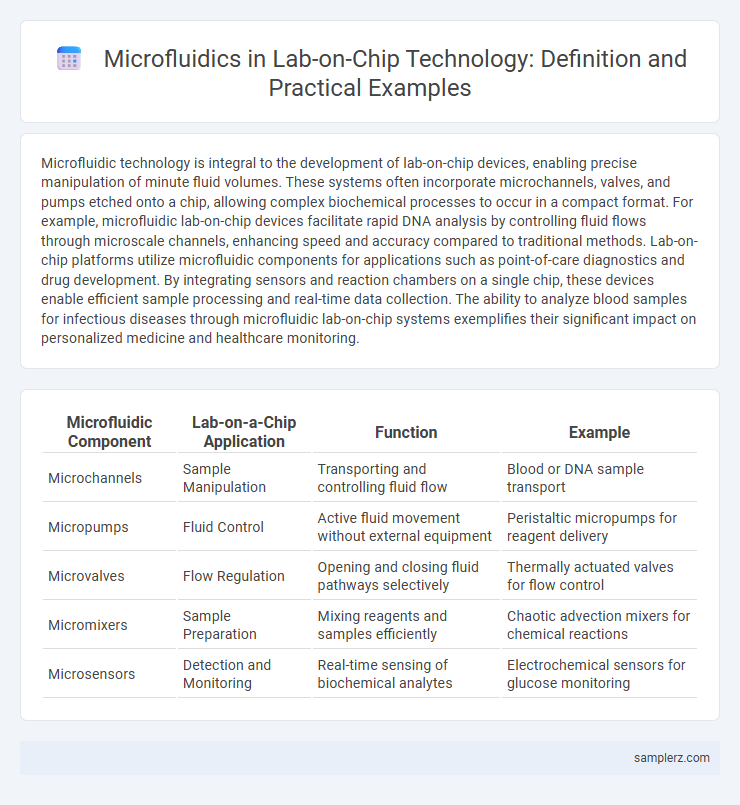Microfluidic technology is integral to the development of lab-on-chip devices, enabling precise manipulation of minute fluid volumes. These systems often incorporate microchannels, valves, and pumps etched onto a chip, allowing complex biochemical processes to occur in a compact format. For example, microfluidic lab-on-chip devices facilitate rapid DNA analysis by controlling fluid flows through microscale channels, enhancing speed and accuracy compared to traditional methods. Lab-on-chip platforms utilize microfluidic components for applications such as point-of-care diagnostics and drug development. By integrating sensors and reaction chambers on a single chip, these devices enable efficient sample processing and real-time data collection. The ability to analyze blood samples for infectious diseases through microfluidic lab-on-chip systems exemplifies their significant impact on personalized medicine and healthcare monitoring.
Table of Comparison
| Microfluidic Component | Lab-on-a-Chip Application | Function | Example |
|---|---|---|---|
| Microchannels | Sample Manipulation | Transporting and controlling fluid flow | Blood or DNA sample transport |
| Micropumps | Fluid Control | Active fluid movement without external equipment | Peristaltic micropumps for reagent delivery |
| Microvalves | Flow Regulation | Opening and closing fluid pathways selectively | Thermally actuated valves for flow control |
| Micromixers | Sample Preparation | Mixing reagents and samples efficiently | Chaotic advection mixers for chemical reactions |
| Microsensors | Detection and Monitoring | Real-time sensing of biochemical analytes | Electrochemical sensors for glucose monitoring |
Introduction to Microfluidics in Lab-on-Chip Technology
Microfluidics in lab-on-chip technology enables precise manipulation of tiny fluid volumes within microscale channels, revolutionizing biochemical analysis and diagnostics. These miniaturized systems integrate functions such as sample preparation, mixing, and detection on a single chip, significantly reducing reagent consumption and processing time. Applications include point-of-care testing, drug development, and environmental monitoring, offering high sensitivity and rapid results.
Droplet-Based Microfluidic Systems in Diagnostics
Droplet-based microfluidic systems enable precise manipulation of picoliter to nanoliter droplets, revolutionizing diagnostic assays by allowing high-throughput screening with minimal reagent consumption. These systems enhance sensitivity and specificity in detecting biomarkers for diseases such as cancer, infectious diseases, and genetic disorders. Integration with lab-on-chip devices facilitates rapid, multiplexed analysis, significantly reducing diagnostic time and labor costs in clinical settings.
Organ-on-a-Chip: Microfluidics for Physiological Modeling
Organ-on-a-chip devices utilize microfluidic technology to replicate the dynamic cellular environments of human organs, providing a more accurate physiological model for drug testing and disease research. These systems integrate microchannels that mimic blood flow, enabling precise control over mechanical forces, nutrient delivery, and waste removal in a controlled microenvironment. Advances in microfluidic organ-on-a-chip platforms accelerate personalized medicine development by allowing real-time analysis of cellular responses under physiologically relevant conditions.
Point-of-Care Testing Using Microfluidic Lab-on-Chip Devices
Point-of-care testing (POCT) using microfluidic lab-on-chip devices enables rapid, accurate diagnostics by integrating sample preparation, reaction, and detection on a single chip. These devices utilize microchannels and precise fluid control to analyze blood, saliva, or urine samples within minutes, facilitating immediate clinical decisions. The compact design and low reagent consumption make microfluidic lab-on-chip platforms highly suitable for resource-limited settings and personalized healthcare applications.
Single-Cell Analysis Enabled by Microfluidics
Microfluidic technology in lab-on-chip devices enables precise single-cell analysis by isolating and manipulating individual cells within microchannels, enhancing accuracy in genomic and proteomic studies. The integration of microfluidic pumps, valves, and sensors facilitates high-throughput sorting and real-time monitoring of cellular responses under controlled conditions. This innovation accelerates biomedical research and personalized medicine by providing detailed insights into cell heterogeneity and disease mechanisms at the single-cell level.
Microfluidic PCR Chips for Rapid DNA Amplification
Microfluidic PCR chips enable rapid DNA amplification by integrating thermal cycling and fluid handling on a miniaturized platform, significantly reducing assay time compared to conventional PCR. These lab-on-chip devices utilize precise microchannel design to optimize temperature control and reaction efficiency, enhancing sensitivity and specificity in genetic analysis. Applications span clinical diagnostics, forensic testing, and pathogen detection, demonstrating the critical role of microfluidic PCR chips in advancing point-of-care molecular diagnostics.
Chemical Synthesis in Microfluidic Lab-on-Chip Platforms
Microfluidic lab-on-chip platforms enable precise control of chemical synthesis reactions at microscale, allowing rapid mixing, reaction, and analysis within confined channels. These devices enhance reaction efficiency and selectivity by optimizing reagent flow rates and temperature gradients, reducing reagent consumption and waste. Applications include pharmaceutical drug development, where continuous flow synthesis accelerates the production of complex molecules under controlled conditions.
Environmental Monitoring Applications of Microfluidic Chips
Microfluidic chips in lab-on-chip technology enable precise detection of environmental pollutants such as heavy metals and pesticides at trace levels in water samples. These devices integrate biosensors and chemical sensors to provide real-time monitoring of air and water quality with high sensitivity and minimal reagent consumption. Applications include continuous surveillance of toxic contaminants, facilitating rapid response to pollution events and supporting regulatory compliance in environmental monitoring.
Microfluidic Immunoassay Integration on Lab-on-Chip Devices
Microfluidic immunoassay integration on lab-on-chip devices enables precise manipulation of small fluid volumes, enhancing sensitivity and reducing reagent consumption in diagnostic assays. These systems incorporate microchannels, valves, and sensors to facilitate rapid antigen-antibody interactions and real-time signal detection. Applications in point-of-care testing benefit from accelerated analysis times and improved accuracy through automated, miniaturized immunoassays.
Future Trends in Microfluidic Lab-on-Chip Technologies
Emerging trends in microfluidic lab-on-chip technologies emphasize integration with artificial intelligence for real-time data analysis and enhanced diagnostic accuracy. Advances in 3D printing facilitate the creation of complex microchannel architectures, enabling multifunctional devices tailored for personalized medicine. Nanomaterial incorporation improves sensitivity and fluid control, driving the next generation of portable, cost-effective point-of-care diagnostic platforms.

example of microfluidic in lab-on-chip Infographic
 samplerz.com
samplerz.com